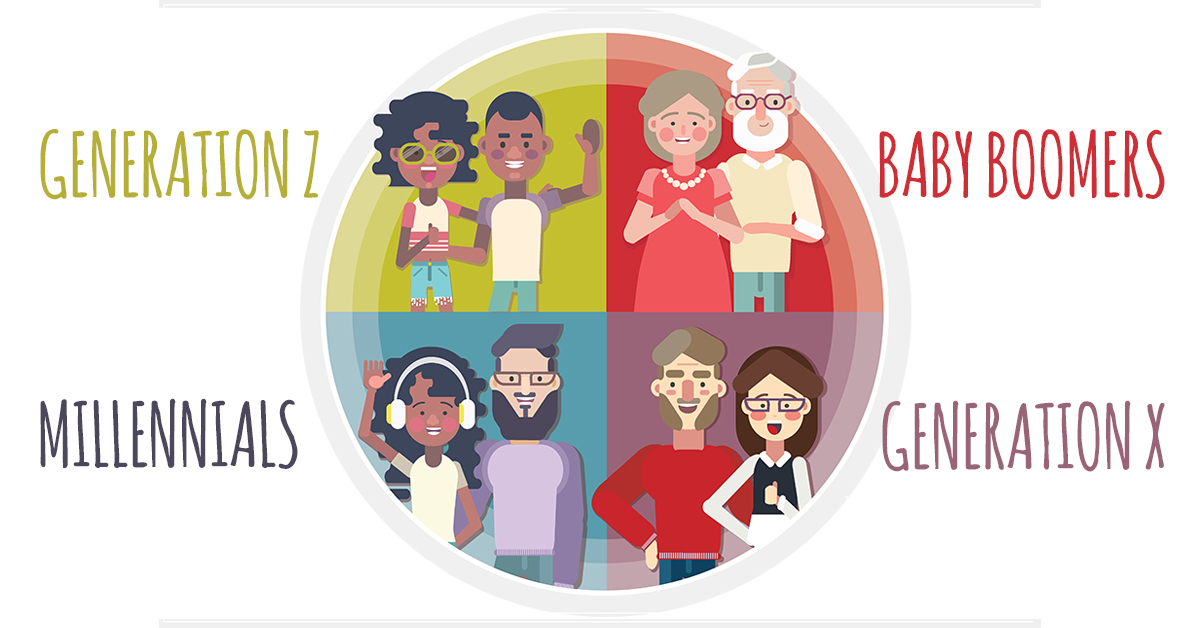“Generational marketing” might sound like a strange concept. After all, marketing is marketing. Determine your product, choose the appropriate message, define your media. Done. Well, there’s more to it than that. Actually, there are specific differences between marketing directed towards Baby Boomers and Generation X, and equally significant ones between Generation X and Generation Z.
So what does this mean in reality? Quite a few things, actually. If you are a company looking to devise a marketing strategy, it would do you good to think carefully about every aspect of your marketing and how you approach it, depending on what generation you’re targeting. And while there is such a thing as “cross-generational marketing,” it still pays to look at what standard generational marketing is based upon. Here is a quick overview of existing generations and what marketing experts see as bases for their respective buying preferences.

Baby Boomers
As you probably know, the term “Baby Boomer” was created after World War II to refer to the generation that suddenly started having lots of children when men came home from the war. In terms of dates, it generally refers to people born between 1946-1964. This was the time when people’s primary form of entertainment switched from radio to television, print media was the norm for newspapers, and postal mail was still a popular way for companies to conduct their marketing.
What does this mean for marketing today?
- Print still holds power for this group. Remember, this is the generation that grew up on Sears catalogs, leaflets sent through the mail, and ads in the New York Times. Online pop-ups might have some effect, but in general this group just sees them as a distraction. Navigating the Internet is cumbersome enough; they would rather do without visual distractions on every corner of their screen, and they tend to ignore them.
- Brands matter. Before the giant diversification of product and service types, there were a finite number of companies that proved their rank above the rest in terms of quality and reliability. Baby Boomers grew up valuing this idea, and they likely still look for certain brand names when it comes to many types of items.
- In-store shopping. While it’s possible that Baby Boomers might shop online, this is not the way that they were raised, and let’s face it: people are fundamentally creatures of habit. Therefore, communication tools directed towards shopping in stores are most effective with Boomers (remember cutting out coupons? Your grandmother certainly does).
Generation X
Generation X is defined as people born between 1965 and 1980. This is the group that witnessed the birth of the personal computer. For them, it was understood that every house should have a television, but they didn’t grow up with the Internet or mobile phones. Gen X were part of the big transition to all things digital and can still remember life without many technological comforts.
Accordingly, characteristics of this generation that companies devising marketing strategies should consider include the following:
- Something of a shift away from brand loyalty, but some loyalty to certain brands. Particularly among people who value prestige, certain clothing brands, for example, remain paramount (Remember Jordache jeans? If you didn’t have a pair of those in high school, you’d be exiled to the corner of the lunch room).
- Mixed-media advertising. Gen Xers still read paper newspapers and magazines, although they’re not as averse to online advertising as their parents are. Most of them aren’t irritated by the prospect of downloading apps onto their mobile phones. Therefore, marketing products and services to this age group involves a mixture of print and online formats.
- They have a certain level of disdain both for technophobes and youngsters terminally glued to their phones. Finding the sweet spot with them is key.
MIllennials
The MIllennial generation refers to people born between 1981 and 1996. By the time even the oldest of this generation turned 10, the Internet was already alive – if even only in its infancy – and personal computers were widespread enough that regular people could access them in computer labs, if not necessarily in their homes.
In terms of marketing strategies aimed at this group, this has major implications:
- Millennials are out of love with print. If any of them do take the time to buy a paper newspaper, it is probably for the sake of novelty (perhaps a role in the school play?). Digital marketing definitely resonates with them, and they tend to believe things they read online.
- Brands went out the window for them. Because this generation grew up with Amazon, they understand that for every pair of jeans you could pay $150 for, you can find an equally good pair for $20. All the specs are laid out right before you. And they know they’re not going to impress their friends with the labels on their clothes. Brands are out, features are in. Email marketing is effective in reaching this group.
Generation Z
People born between 1997 and the 2010s are part of Generation Z. With something of a reputation for being lazy and potentially dangerous to society, this group sometimes bears the derogatory moniker “generation zero.” Gen Z’s distinctive features include a high level of tech savvy, among other things:
- They can make video content themselves and understand the science behind many apps and other technological features. As a result, they are quick to seek out tools that suit their creative needs. While Windows Movie Maker alternatives have become increasingly popular, Gen Z often prefers more advanced or user-friendly software for editing. Programs like Cyberlink PowerDirector, Movavi Video Editor, or OpenShot offer intuitive interfaces and professional-grade features, allowing them to produce high-quality video content without requiring expensive or complex software, fitting their DIY, tech-forward mindset.
- They generally pose a challenge to marketers who, although superior to Gen Zers in age, often lack the skills to really speak to them. Therefore, marketing companies really need to be on top of their game when targeting this group. Video marketing is standard these days, and it definitely needs to be spiffy to impress Gen Z.
- They are not interested in things like loyalty programs, as their parents or grandparents might be, because they know they can always look for cheaper options simply by shopping around.
Times are a-changing, to some extent…
Now, the cross-generational marketing school holds that these stereotypes are too cut and dried and don’t take into sufficient consideration the large degree of crossover between the groups. Proponents of cross-generational marketing believe that there are other ways you can target specific audiences, rather than simply by age.
While this may be true – and will likely become even more true in the future, as fewer and fewer people remember the pre-technological age – it remains the case that stereotypes about the still-existing generations have a basis in reality, and any given marketing strategy should at least take these main points into consideration.
What the defining characteristics of future generations will be has yet to be seen. It would be wise for marketing experts to keep in mind that the world does, in fact, continue to change, and the particular interests of any given group should be given sufficient attention.
After all, everyone thinks their generation is different from the others, and our defining features are what determine our shopping choices. Of course there are other factors than age involved in buying preferences. But we now have the technology to look at all of these factors together, in multiple ways, and speak to people on different levels. Cookie, anyone?
To read more content like this, explore The Brand Hopper
Subscribe to our newsletter
Go to the full page to view and submit the form.

